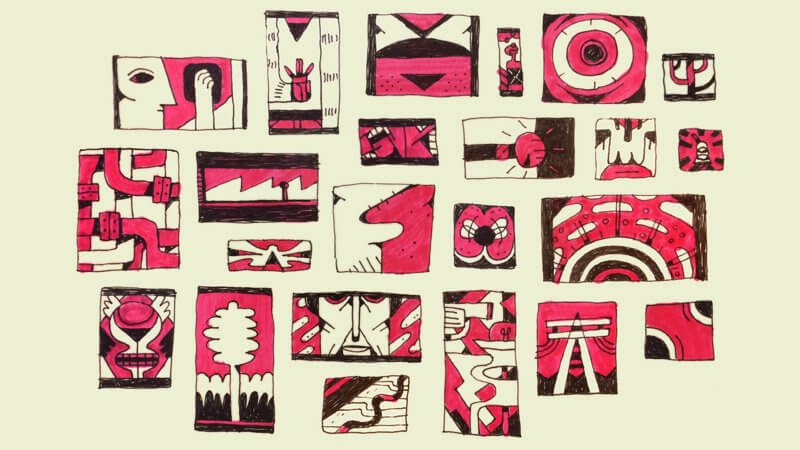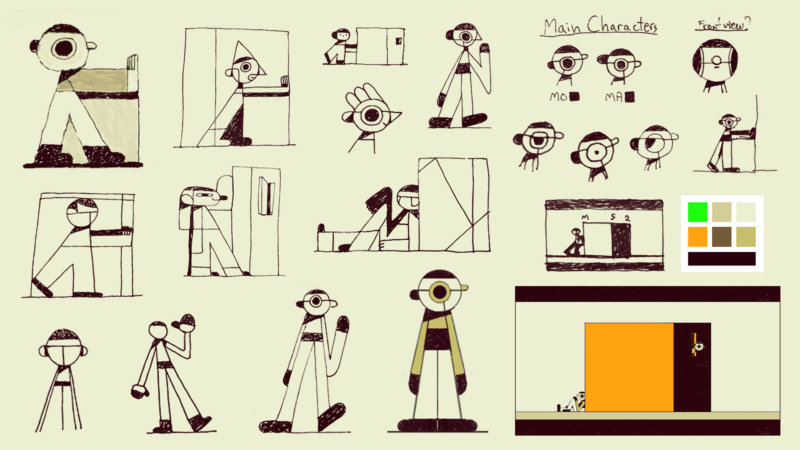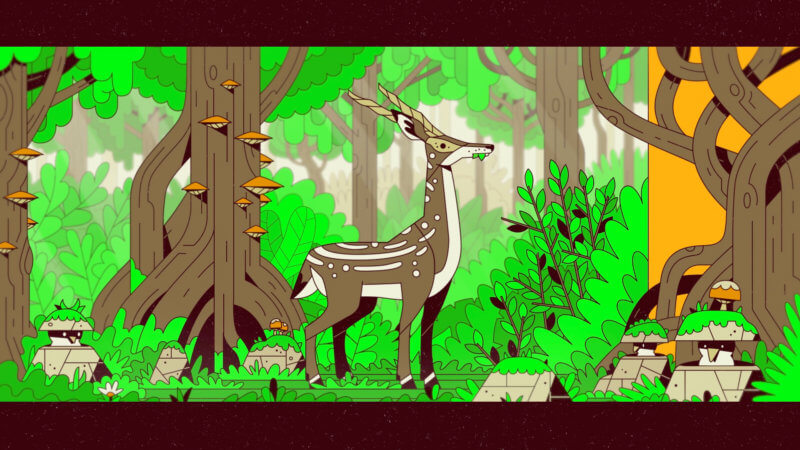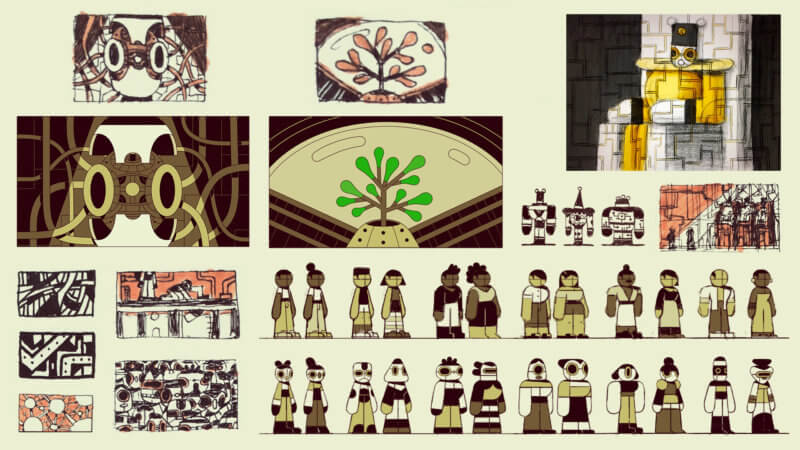Q&A with Yves Paradis (M52)
Hailing from Montreal and presently based in Germany, animation filmmaker and street artist Yves Paradis has been actively working as a freelancer for films, commercials, video games and music videos. A recent highlight of his independently-produced personal work has been the ten-minute labour of love M52, an entirely improvised short film made in weekly instalments throughout 2017.
Beginning without any script, storyboard or design from the outset, save for a curious figure pushing a large box against an empty backdrop, M52 would eventually craft an elaborate and increasingly ambitious sci-fi world. The final film, which boasts consistently appealing design, sophisticated animation principles and a captivating score by Alexander Hohaus, would go on to screen at major international festivals including Encounters, ITFS Stuttgart and Pictoplasma.
With recent UK screenings including Cardiff Animation Nights and ahead of our upcoming Skwigly Screening at the Manchester Animation Festival we reached out to Yves to learn more about his work, background and committing to such a unique labour of love.
What initially started you on the path to art and animation?
I originally wanted to study graphic design, but a friend of mine told me about an animation school and I liked the idea. I immediately fell in love with this art form.
As well as animation you also have a propensity toward street art – what drew you to this as a form of creative expression?
My older brother was making graffiti and it influenced me to give it a try. I started making street art when I entered high school and it became a first step in learning rules of graphic design and dynamic composition. Now that I’m working most of the time on a computer in an office, going out to paint and interact with the environment feels like a great way to break the routine and challenge myself on other creative levels.
Alongside your own art you’ve produced animation work for a variety of commissions including games and music videos. Are there any professional projects you’re most proud of?
The game projects I worked on were all very formative in term of learning about work pipelines, project management and team building. But the last two music videos I recently made, as well as my short film M52, are projects I am especially proud of since they allowed me to develop my own creative identity and brought me a step further in my creative journey. It was also the first time I produced films of this size all by myself over a short period of time.
You’re presently based in Germany, what prompted the move from Montreal?
I originally though about moving to Europe after going to a festival called Supertoon in Croatia where I met plenty of kind and talented artists. This glimpse of the European animation culture was very eye-opening. About a year later, I met my girlfriend and I decided to move back with her to the city where she lived in Germany. It was a beautiful coincidence.
How does living in Germany as a creative artist compare? Are there any significant differences to how the arts are regarded in terms of government/community from your perspective?
The long years and tradition of maintaining the culture of art in Germany and Europe have made it a very important aspect of life. It’s a great feeling to have this mentality to support you as an artist. I also feel there is more investment in art overall then in Quebec and Canada. At least in the field of film and animation.
What led to you starting M52 as an improvisational project, and did you plan from the outset to eventually have it be a 10-minute film?
I first made a creative challenge in 2015 about 365 days of art. Then I gave myself a break and wanted to try the experience again but with animation this time. After seeing the ”Mystical Mondays” of Greg Gunn and the ”30 Days of Animation” from Geoff King, I knew this next challenge would take the form of an improvised animated project. I also wanted to make a new short film with less constraint and a more intuitive workflow. Every scene where made without time restriction. As long as the timing felt right and I could manage to do it in a week, I didn’t mind. I never thought this challenge would end as a 10 minutes of animation!
Was it difficult to maintain that level of weekly commitment once you had started, or did time available ultimately determine where and how the story progressed?
It wasn’t difficult to maintain the commitment since the project highly motivated me. Time definitely had a big impact on how the story progress. Especially at the beginning since I had no idea of where the story would go. A key point was to choose simple narrative and visual solution to do what I had in mind for the animation of the week.
Were there any major challenges or sacrifices that committing to the project entailed?
Time management was of course a big challenge. Particularly when I had a more busy week of freelancing work or was abroad for personal or work purpose. Shorter nights of sleep inevitably happened from time to time. Although, in general I didn’t wanted to cut on the quality of the animation or on the time I spent with my friends and family. So I gave myself the boundary to complete this challenge with the flexibility to delay a week of animation to the next one when I couldn’t make it. I would therefore have to do double the work the following week. As long as I could finish the year with 52 sequences of animation, I was okay to sacrifice some of the commitment of releasing an animation per week in order to be proud of what I’m creating. In the end, the intention of this challenge was for me to create more often on a regular basis and explore new creative horizons.
Did developing the story and visuals in increments on a week-by-week basis make the process easier or did that level of creative restraint prove challenging in itself?
For the visual, it made it easy and gave me a very natural workflow. As I started with minimalist design, I ended up developing the graphic bible of the film by increments based on the needs of the narrative. This was a flexible pipeline that allowed me to play with the visual identity of the film’s universe until the end. It was also more fun than a typical production where almost all the creative decisions are taken at the beginning. Regarding the story, the first 3 months were completely improvised and this process was surprisingly convenient. It’s very different to work this way. You only have to think about what will happen next based on what happened before. After that period, the story actually unfolded quickly and I knew roughly where it would go. I still forced myself to not plan any weeks in advance beside a one liner for each block of the remaining story.
Despite being made chronologically over such an extended time period the overall design and tone of the film maintains a uniform style throughout. Did you have anything set in place to ensure this consistency?
The minimalist geometric design and colour palette were the main rules I chose from the beginning. But I was really pleased by the general unity of the film when it was completed, especially that the beginning and the end still fit well together.
The colour palette and lighting approaches are incredibly effective. Did you have a specific process or influences when it came to developing these?
Working with less colour forces you to make the best out of it and find alternatives for expressing the feelings you want to convey. When it comes to giving emotion or tension in a scene for example, this constraint can actually become an advantage by having stronger contrast in the general ambiance.
On reflection what would you say are the main positives you’ve taken away from the experience of making M52?
To see that it’s possible to be very efficient and creative when you give yourself the right structure to do it. Also that going out of your comfort zone and experimenting with new ways of working can push you much further in your artistic development.
Having made other short films in the past was the approach you took with M52 preferable?
I don’t think this approach of working with a lot of unknowns is suitable for every project, although I would definitely like to try this method again on another film. What stands out is that being more intuitive and flexible in the early development of a short film can be very beneficial for the whole project.
Would you take on this type of project again?
Without a doubt!
Were there any particular influences (literary/cinematic/other) on the story itself?
As I started with the cube as a central element, the film Cube by Vincenzo Natali indirectly had some influence later on when I developed the story. But I was mostly driven by the themes of dystopian future and the disconnection between human and nature in the development of modern civilisation. Also, the work of Isaac Asimov and other science fiction author strongly forged my imagination when I was a kid.
Is there anything that you’re working on since/now that you can discuss?
I am currently working on a script and concept for a new short film. This time made with a more typical pre-production pipeline. The subject is about communication and language.
M52 screens next week as part of our Skwigly Screening at the Manchester Animation Festival, 5pm 13/11 at HOME. See more of the work of Yves Paradis at yvesparadis.co





